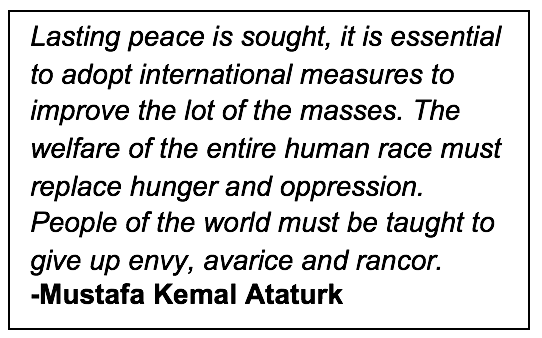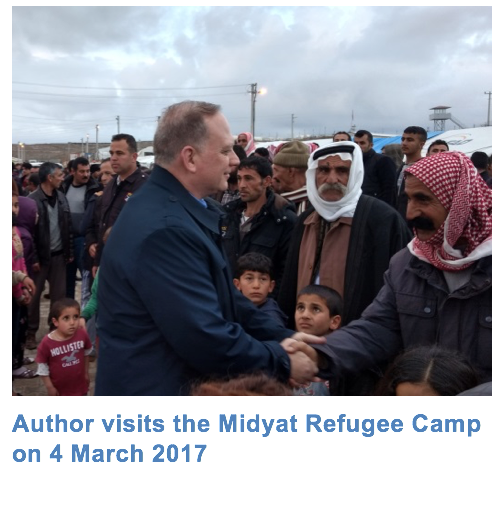
Turkey Continues to Shoulder the Refugee Burden
According to UN Refugee Agency (UNHCR) data released last year, there are 65.3 million forcibly displaced people around the world: 21.3 million are refugees, over half of whom are under the age of 18. The UNHCR also reported that the number of displaced people is at its highest level ever, surpassing even post-World War II numbers. In fact, one out of every 113 people on Earth is currently displaced.
 As is well documented, the countries of the Middle East are on the front lines of this situation, with Turkey, the nation where East meets West, playing point. Last month, the Turkish government released new refugee data indicating it now hosts the largest refugee population in the world; this influx of more than 3.5 million refugees—predominantly fueled by millions of Syrians who fled north to escape their country’s protracted civil war, as well as those from Iraq, Afghanistan and Africa—places the scale of Turkey’s refugee situation well ahead of Pakistan, Lebanon, Iran, Ethiopia and Jordan. Reportedly, not one of Turkey’s 81 provinces is without a refugee community.
As is well documented, the countries of the Middle East are on the front lines of this situation, with Turkey, the nation where East meets West, playing point. Last month, the Turkish government released new refugee data indicating it now hosts the largest refugee population in the world; this influx of more than 3.5 million refugees—predominantly fueled by millions of Syrians who fled north to escape their country’s protracted civil war, as well as those from Iraq, Afghanistan and Africa—places the scale of Turkey’s refugee situation well ahead of Pakistan, Lebanon, Iran, Ethiopia and Jordan. Reportedly, not one of Turkey’s 81 provinces is without a refugee community.
However, Turkey’s status as home to the world’s largest refugee population is an impressive undertaking—an undertaking seemingly lost on many audiences.
 In contrast, while much is made of Europe’s attitudes toward and challenges with refugees, the European Union’s migration policy remains in seeming disarray.
In contrast, while much is made of Europe’s attitudes toward and challenges with refugees, the European Union’s migration policy remains in seeming disarray.
With literally nowhere else to go, the refugee situation in Turkey has become seemingly permanent. Turkey’s overall population of 80 million has seen a rise by almost 5 percent due to mass migration, while annual growth of its local population is approximately 1.3 percent. To deal effectively with its growing population, Turkey will require an integration strategy that takes into consideration the needs and resources of host communities, strain on public resources and broader educational and employment training efforts.According to Amnesty International, 27 European Union countries, with the exclusion Germany, have pledged 51,205 places for resettlement; however, these pledged resettlements would only take in around 1 percent of the Syrian refugee population represented in the main host countries.
The Turkish government has already begun to make inroads on such a strategy. Recognized as “guests,” millions of refugees now have the right to attend school and hold jobs. This move was praised by the ILO, United Nations High Commissioner for Refugees and Refugees’ International. In 2015, Turkey managed to enroll 215,000 Syrian children into primary and secondary education, a significant improvement from the previous year (although it only comprises a small number of the more than 700,000 school-aged Syrian children living in Turkey).
These are all steps in the right direction, but given the scale of the situation, much progress remains. With the benefit of a comprehensive, properly managed and well-suited migration policy, though, refugees could have the potential to make positive contributions to the diverse social and economic life in Turkey in the not so distant future.
Mainstream media tends to paint a somber picture of the current refugee situation, but it’s important to remember how remarkable the Turkish government and people have been in handling this humanitarian crisis.
Having recently visited the Midyat Refugee Camp, the author witnessed firsthand the scale of the tremendous humanitarian efforts taking place. Of course, there is always more work to be done. There are 26 government-run camps across Turkey in addition to the millions of Turkish families who have taken in their neighbors. Those who work to support the camps consider the refugees as both guests and individuals who may very well remain in Turkey as brothers and sisters. This sentiment is not unprecedented in the country’s recent history, as Turkey absorbed migrants from Bulgaria in 1989 and Bosnia in the early 1990s.
Despite the generous efforts of the government, local authorities and host communities, of the nearly 2.8 million registered Syrian refugees in Turkey, only 10 percent are settled in the 26 camps run by the Disaster and Emergency Management Presidency of Turkey (AFAD), where they have access to food, shelter, healthcare, education and social activities. 90 percent of Syrian refugees, as well as many refugees from other nations, still live outside these camps under challenging circumstances and with scarce resources. For these refugees, access to basic facilities is often limited for reasons such as requirements for registration with local authorities or language constraints.
Turkey’s status as home to the world’s largest refugee population also runs up significantly high costs. Official government estimates indicate that Turkey has spent 25 billion USD for Syrian refugees alone.
Of course, the best-case scenario is for all the refugees to return to their homes. Many of those from Iraq or Afghanistan have done so, but it’s not the case for Syrians and it may not be so for the foreseeable future until they can return to a secure environment. In the meantime, countries like Turkey will likely continue to bear the brunt of this international challenge.

